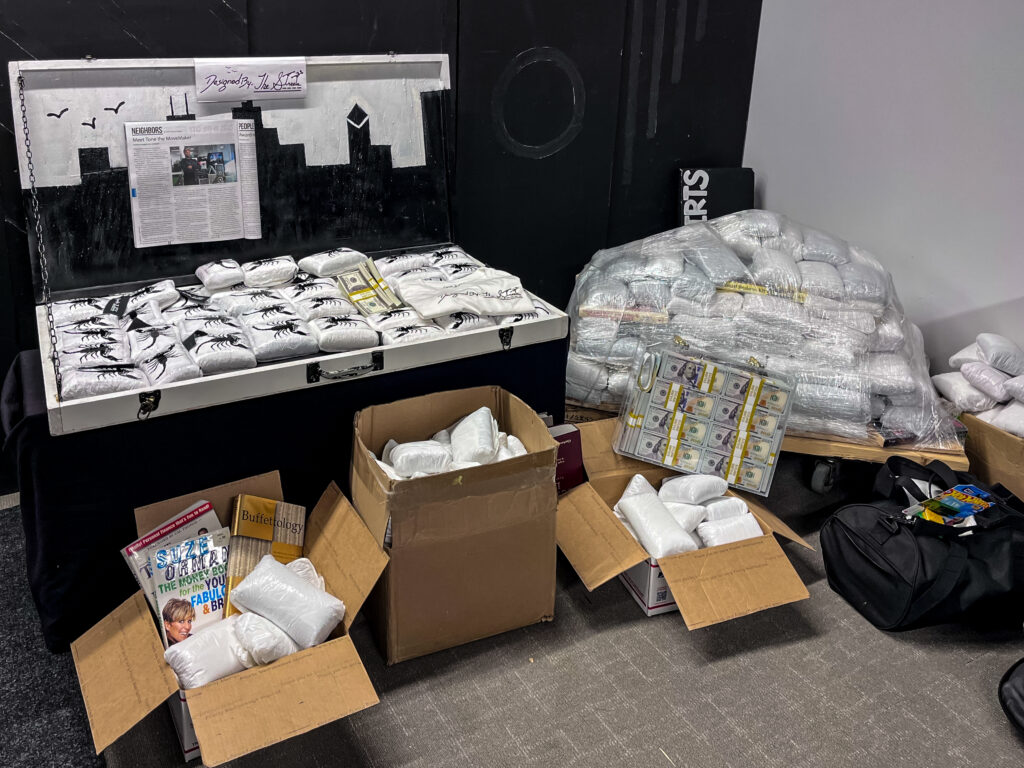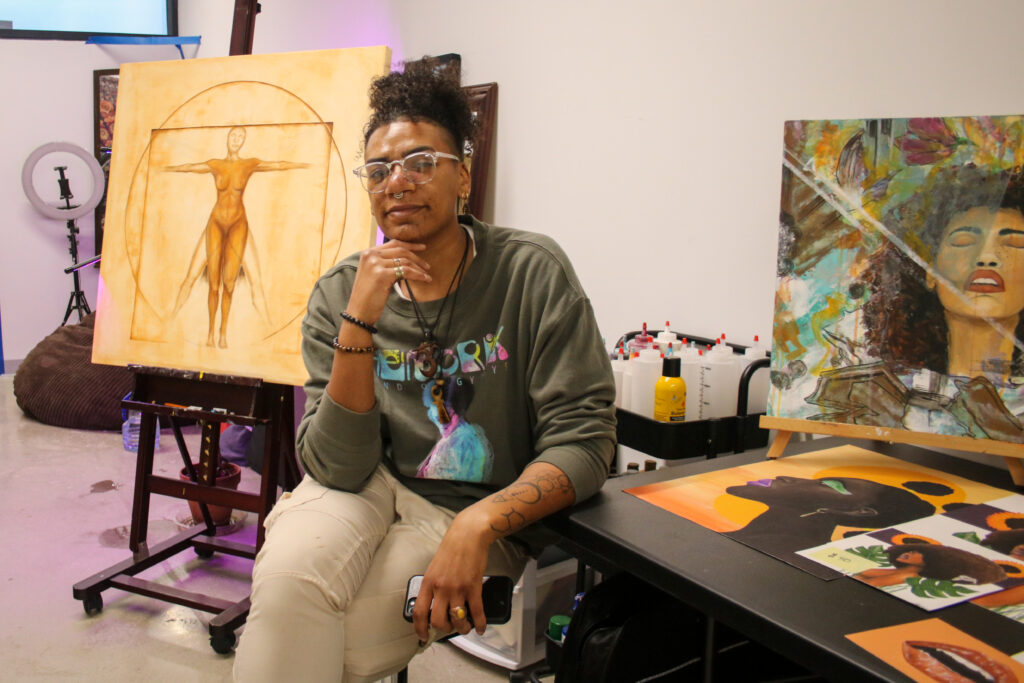No one is really inspired by a data center — except maybe Justin Mandelbaum. When the Des Moines developer purchased the building that would become Mainframe Studios from internet provider CenturyLink in 2014, he saw something that other people didn’t: a community. He just needed to build it.
He’d done it before, overseeing Western Avenue Studios in Lowell, Massachusetts. But the building at 900 Keosauqua Way, on the north edge of downtown Des Moines, needed a lot of work. There were 160 new windows to install, roughly 100,000 square feet of new concrete to pour and 180 individual artist studios to segment off. It’s taken years to make it all happen, with floors being completed and opened to artists one by one.
In the end, Mainframe was transformed into the largest affordable, nonprofit creative space in the country. According to Siobhan Spain, the executive director of Mainframe Studios, it operates at nearly full capacity and constantly has a healthy wait list — currently sitting at about 80 applicants. And those lucky enough to have a space represent 30 different disciplines, including painting, sculpture, dancing, music, fashion design, glass blowing, game development and more. The first Friday of every month, they all open their doors to the public — five floors of artists promoting their work all at once.
“You can come and experience a new genre or event or heritage that expands the community’s awareness of what’s around them and all the potential this community has, but also brings them together in a really safe place,” Spain said.
Lani Eclatt
For Lani Eclatt, seeing other artists working on their craft inspired work in her own music.
“I think it helps create this energy in Des Moines,” Eclatt said. “That we’re more than just an Iowa town, and there’s so much talent here that exists. It helps to put Des Moines on the national stage, art-wise, music-wise, creative-wise.”
Eclatt works as the Mainframe Studios property manager by day, and a musician/singer/songwriter by night in her studio on the second floor.
Eclatt started working at Mainframe Studios in July 2022 after she heard about the position from her mom, who has her own print-shop studio on the third floor. After she had been working there a few months and the second floor was completed, Eclatt got her own studio, too.
She has been writing music since she was a kid. She always knew she wanted to be on stage. In 2021, thanks to the extra time the pandemic provided, she finally started taking her career more seriously. She started off by playing anywhere and everywhere she could for free. Slowly, she built some credibility, and started charging for her gigs. Now, Eclatt is a part of three different bands — one, of course, being her own — and has an album, Love Lani, coming out in July.
A lot of her music was inspired by Mainframe. Eclatt sees the networks that each individual artist brings to Mainframe as one of its biggest benefits. The possibilities explode from the number of people and connections all in one place.
“This is a real unique thing. Artist buildings do exist, but are they affordable? Not really,” she said. “Are they convenient? Not so much. Are they full of fun community events that you get to engage in as an artist and expand your network and get clientele? Not really.”
Mainframe is changing the game.
Tone the MoveMaker
Tone the MoveMaker got his studio space after building connections with the art community at Mainframe his own way. During the day, he would hang out around Mainframe. Eventually, he got close with Spain. She told him there was an open studio space on the third floor — right as he was considering leaving Iowa, of course. But Tone knew Mainframe was special.
“Mainframe is the headquarters for Central Iowa art,” he said. “It’s 180-something artists in one space every day all day, working their butt off and it’s just no other place that can match that productivity.”

Tone respects the hustle. He’s been doing it for years. He got his start as a kid, making beats for his sixth grade friends. A couple years later, he started shooting music videos for them, too. That led to booking shows and promoting concerts. After that, he wanted to start his own business, but he didn’t understand how. A visit to Iowa State University to see his brother fixed that. He realized school was just what he needed. Of course, he didn’t need to pay. Instead, he sat in on different classes and held on-campus jobs despite not being an actual student to get by. He even sold hot dogs on campus to make some cash.
Now, he does it all: music, fashion, painting, film, 3D printing and AI, with his clothes themed around his current art projects — all under the brand Designed by the Streets.
One of the things that set Tone apart is the way he packages his clothing — as kilos of cocaine. Tone started doing this because he wanted to show people where he came from. When he originally moved to Iowa, Tone wanted to bring his friend with him as a business partner. That friend ended up going to jail for possession of a kilo of cocaine.
“Same rule, same hustle, different product,” he said. “You can make it off your street knowledge if you just apply it to the business world, you know, instead of trying to do crime or whatever else you get into.”
Jess Quinn
Jess Quinn has been with Mainframe Studios since the beginning. She has been in three different studios as the nonprofit has grown. She has seen how artists feed off each others’ creativity. And it goes beyond just them.
“Those who have even a little bit of a creative bug in them,” she said, “when they walk the halls or they come for First Fridays, they’re buzzing with excitement. They’re like, ‘Oh, I want to go home and paint. I want to get my stuff out again. I want to do this.’ So I think it’s like a big energy drink for people.”
Years ago, she got her degree in Art Education and was a teacher for 10 years before she left. Now, at Mainframe, she shows her art and teaches private and group lessons to children, teens and adults.
Quinn doesn’t go to any festivals to sell her art, so Mainframe is the community exposure she needs. Plus, her studio gives her the space to teach and be around other like-minded people.
“I don’t keep to myself what I learned. I’m a teacher at heart,” Quinn said. “So if somebody wants to ask about how I price, how did they figure this out, or how to overcome that, I’ll tell them my journey. And I think that’s a big part of the growth with this place, too.”
Indigo Moore
Indigo Moore hopes other black women can see themselves in her art. She’s an oil painter. Her work evokes a sense of peace, of calmness, but also female empowerment. There are representations of black women, of self love, and reflections of the higher self. But ultimately, her paintings are a message to herself, a way for Moore to overcome her own insecurities.
“You hear ‘accepting women’s bodies’ all the time but sometimes you don’t always feel that,” she said. “Painting it and creating it actually really helped me have self-love for myself.

Over the last few months, Moore has been busy working on her first mural painting with Jill Wells at King Elementary.
“I hope that I can also help other artists that want to do murals,” Moore said. “Also helping kids too when we’re at the schools. Art is a lot more needed in the school system than it’s given credit. It’s being defunded and kids need to be creative. Kids need to build that neuroplasticity in their mind with creation and experience.”
Even if you can’t purchase a local artist’s work at this time, Moore urges the public to share, follow and like their work. It goes a long way.
Linda Lewis
Linda Lewis is a retired teacher and current sculptor. She shares a studio on the third floor with two other artists. Lewis mainly works with clay. She also paints the pieces, rather than glaze-dipping them.
Lewis only started about 12 or 13 years ago. When she decided to spend more time working with clay, she didn’t want to go back to school to get another degree. She worked with a well-known artist every year and treated it like her own “independent study.”
“I think it accelerated what I was able to do where I think I would’ve been just kind of floundering on my own,” she said. “I had some really nice people that nurtured me.”
Lewis likes to make pieces that have underlying messages and make people think while still portraying hope.
“I’m not very poetic wordwise, but I like to be poetic visually,” she said.
When Lewis started out at Mainframe, First Fridays weren’t very busy, but now, she feels they are “changing the culture” in Des Moines. There’s increased diversity in the artists and visitors who stop by the studio.
Since Lewis has been there from the beginning, she has seen growth in a lot of artists’ work.
“It makes it very exciting because that actually improves the creative process when you are around people who don’t think like you,” she said. “If you’re around people who think like you and paint like you and do ceramics like you, you won’t really do anything new or unique or any different.”

